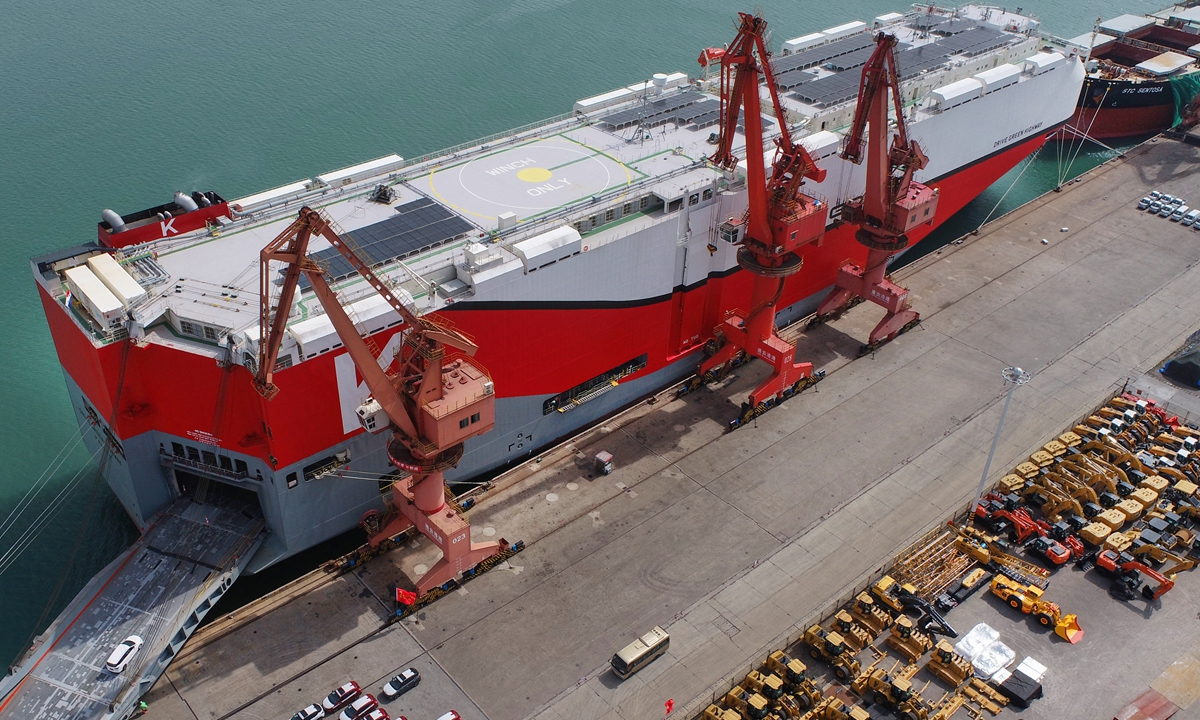
3,053 units of domestically made vehicles are ready to be exported from Lianyungang port, East China's Jiangsu Province on Thursday, a record high for a single vehicle export volume. After the batch of cars is loaded, they will be exported to Mexico and Australia by sea. Photo: cnsphoto
About 40 percent of Chinese exporters recently surveyed by the Ministry of Commerce (MOFCOM) reported year-on-year growth in new export orders, reflecting improvement in overseas demand and firms' increased competitiveness, an official said on Monday.
However, officials have also highlighted challenges for Chinese exporters and have vowed to take various measures, including boosting cross-border e-commerce trade, to stabilize trade going forward.
Assistant Minister of Commerce Ren Hongbin told a press conference in Beijing that he has confidence that the country could achieve the goal of steady expansion and improved quality in imports and exports this year despite challenges.
In addition to external challenges such as severe outbreaks of the COVID-19 overseas and increasingly politicized trade ties, Chinese foreign trade enterprises face four major difficulties: inefficient but expensive international shipping, a volatile yuan, rising raw material prices and increased labor costs, according to Ren.
In this regard, the MOFCOM will come up with policies or measures like strengthening international economic and trade cooperation, boosting the development of the Belt and Road Initiative, and facilitating new forms and models of foreign trade to advance high-quality development of the trade sector, Ren said.
The comment came as some media reports voiced concerns of potentially slower growth in China's trade in the coming months amid the challenges. It also came a day ahead of official trade data to be released on Tuesday.
In the first five months of the year, China's total cross-border e-commerce trade soared 36.9 percent to over 700 billion yuan ($108.15 billion), while the volume increased 10 times over the past five years, official data showed.
Meanwhile, Chinese companies have built more than 1,900 overseas warehouses, approximately 90 percent of which are located in North America, Europe and Asia.
According to a document issued by the General Office of the State Council, the country's cabinet, on Friday, China aims for better mechanisms and policy systems for new forms and models of foreign trade by 2025, backed by leading enterprises and industrial clusters with global competitiveness.
To facilitate cross-border e-commerce, the cabinet stressed designating more areas as integrated pilot zones for cross-border e-commerce, with a goal of nurturing about 10 domestic and foreign-trade integrated markets with exports exceeding 100 billion yuan by 2025.
Ren said that China will further cut the negative list covering foreign investment, promote more pilot zones for opening-up in the services sector and steadily boost the development of the Hainan Free Trade Port to stabilize foreign trade and foreign investment.
In addition to promoting the on-time implementation of the Regional Comprehensive Economic Partnership, China will actively consider joining the Comprehensive and Progressive Agreement for Trans-Pacific Partnership and accelerate free trade talks such as the China-Japan-South Korea free trade deal, Ren said.




